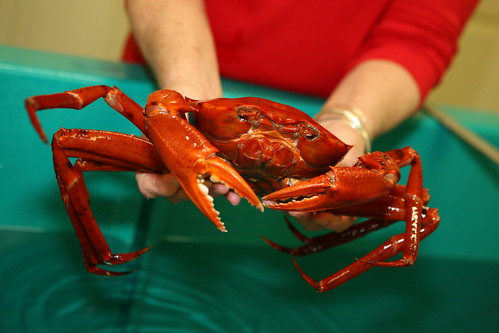We have much more to do and your continued support is needed now more than ever.
Are Red Crabs the Latest Victims of the Gulf Oil Disaster?
Life under 3,000 feet of sea water is tough enough. More than 1,300 pounds per square inch of pressure squeeze you. Water temperatures of 41°-45° F keep you freshly chilled. Hunting for food means scratching and scraping through the sand and silt on the bottom. Who needs a couple hundred thousand gallons of oil and methane dumped into the neighborhood?
Since the Gulf oil disaster there’s evidence of health and behavior changes in the native red crab population. “They’re not defending their turf,” said Harriet Perry, director of the Center for Fisheries Research and Development at Gulf Coast Research Laboratory (GCRL) in Ocean Springs, Miss.

Perry, a hands-on field biologist who has been studying Gulf fisheries for more than 30 years, can see something different happening.
Just 12 miles from the Deepwater Horizon well head, red crabs are being displaced by a deepwater, grey shelled giant isopod called Bathynomus giganteus.
Isopods are crustaceans, usually shrimp-sized or smaller, resembling woodlice or what kids call roly-polies. Bathynomus, a deep sea critter that’s been scavenging ocean floors for about 160 million years, is big — usually about a foot long. One specimen brought up the Gulf’s depths measured more than two feet long.
But the crustacean’s size isn’t news; the fact that red crabs are being pushed around by Bathynomus is.
In the area near the wellhead, traps that historically caught more than 30 crabs each came up with very few live crabs, most were dead. “They had enough energy to get in the trap and normally they will survive the trip from the bottom to the surface and do well,” said Perry. But the few live crabs that made it to the surface were weak and lethargic.

The real surprise came when traps brought up Bathynomus instead of the previously abundant red crab. “Being that close to the well and knowing how much oil and dispersant went into the water, I really anticipated no catch in that area and was surprised when we did get animals,” said Perry. “We saw no obvious signs of oil. When crabs or isopods came up in the traps they weren’t oily but they were stressed,” she added. Which is to say, most of the Bathynomus were dead on arrival or close to it. Within days all were dead.
Deep-sea crab surveys have been few and far between. There were several studies in the Gulf of Mexico in the late 1980s and early 90s so there are some historic data on the populations. The red crab has supported a commercial fishery in New England and there are more data on that fishery because it’s managed. Because there’s no current commercial fishery of red crabs in the Gulf, and there won’t be one any time soon (hauling traps up from 3,000-6,000 foot depths isn’t very profitable), there’s only the existing science that can be used to assess the impacts of oil on this deepwater community.
So in keeping with the federal government’s 50-year-long “Let’s just put 4,000 oil and gas wells into the Gulf of Mexico; what could go wrong?” program, there’s no immediate funding to support new trapping sets. “We don’t know where the crabs went, or why,” said Perry.
Scientists don’t know if red crabs were displaced by Bathynomus because something weakened them physically or they responded to some adverse environmental change, like low oxygen or oil in the water. We also don’t know if they have moved down the slope, though they’re limited to a narrow band on the steep slope where the temperature stays around 41° F.
What’s most worrisome is that the unexpected displacement of red crabs by Bathynomus may be an indication of other post-oil-spill surprises to come.
Perry has collected red crab tissue samples —fat glands, gonads, gills and muscle tissue — to send to several labs for analysis.
“They’re totally tied to the bottom and we know from a previous study that they accumulate heavy metals in their tissues,” said Perry. “That’s one reason we are interested in looking at the heavy metal content of their tissues following the spill,” she added.
Also, the labs will analyze for compounds that make up Corexit, the dispersant BP sprayed on the water surface and, later, poured directly into the oil spewing from the well head on the sea floor and for petroleum compounds.
“There’s something going on down there and we need to understand it,” said Perry.
To see what a red crab & a giant isopod look like side by side, visit NWF on Flickr. To learn more about the National Wildlife Federation’s Gulf oil disaster response, visit NWF.org/OilSpill.





















